Paper Menu >>
Journal Menu >>
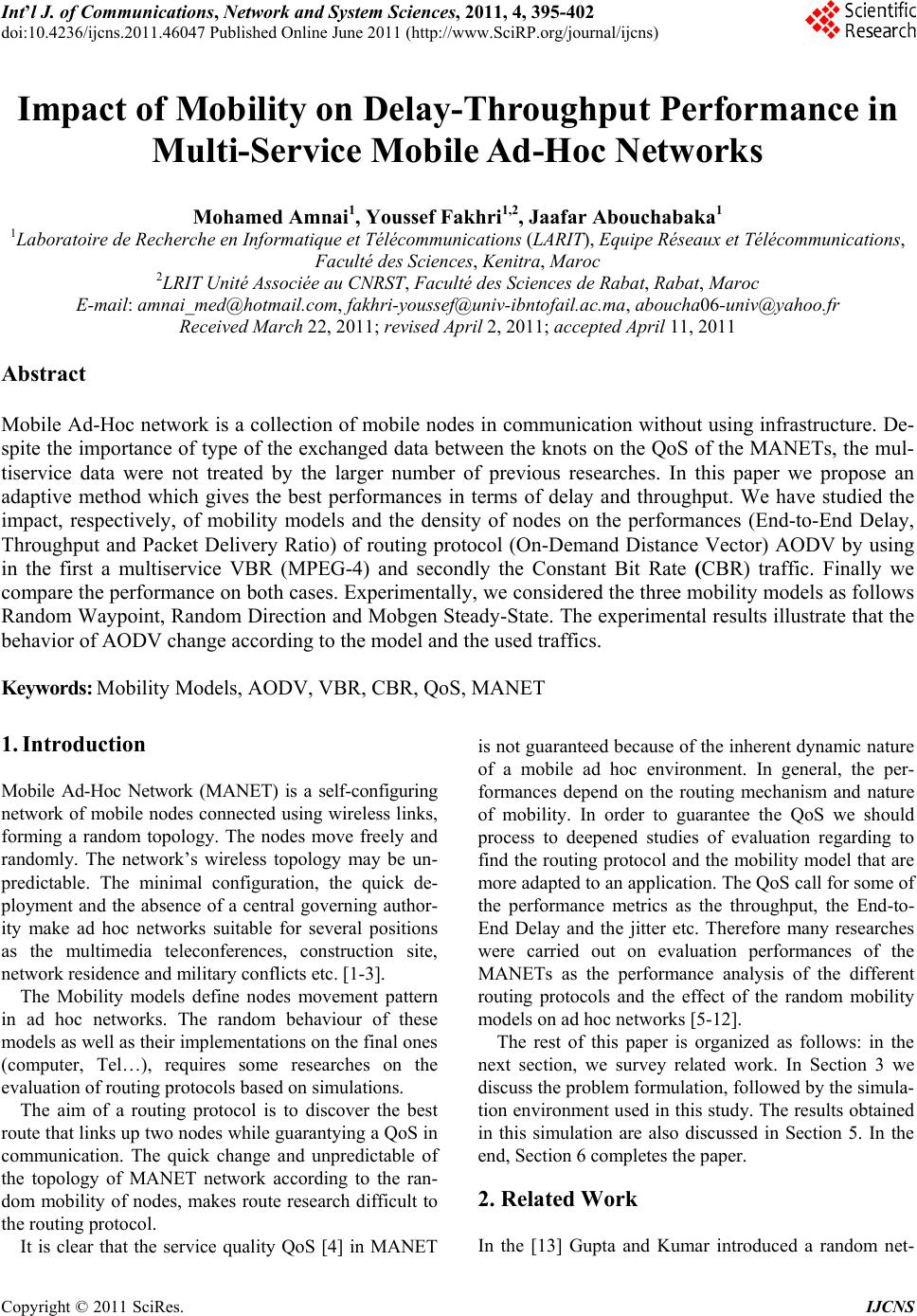 Int’l J. of Communications, Network and System Sciences, 2011, 4, 395-402 doi:10.4236/ijcns.2011.46047 Published Online June 2011 (http://www.SciRP.org/journal/ijcns) Copyright © 2011 SciRes. IJCNS Impact of Mobility on Delay-Throughput Performance in Multi-Service Mobile Ad-Hoc Networks Mohamed Amnai1, Youssef Fakhri1,2, J aafar Abouchabaka1 1Laboratoire de Recherche en Informatique et Télécommunications (LARIT), Equipe Réseaux et Télécommunications, Faculté des Sciences, Kenitra, Maroc 2LRIT Unité Associée au CNRST, Faculté des Sciences de Rabat, Rabat, Maroc E-mail: amnai_med@hotmail.com, fakhri-youssef@univ-ibntofail.ac.ma, aboucha06-univ@yahoo.fr Received March 22 , 20 1 1; revised April 2, 2011; accepted April 11, 2011 Abstract Mobile Ad-Hoc network is a collection of mobile nodes in communication without using infrastructure. De- spite the importance of type of the exchanged data between the knots on the QoS of the MANETs, the mul- tiservice data were not treated by the larger number of previous researches. In this paper we propose an adaptive method which gives the best performances in terms of delay and throughput. We have studied the impact, respectively, of mobility models and the density of nodes on the performances (End-to-End Delay, Throughput and Packet Delivery Ratio) of routing protocol (On-Demand Distance Vector) AODV by using in the first a multiservice VBR (MPEG-4) and secondly the Constant Bit Rate (CBR) traffic. Finally we compare the performance on both cases. Experimentally, we considered the three mobility models as follows Random Waypoint, Random Direction and Mobgen Steady-State. The experimental results illustrate that the behavior of AODV change according to the model and the used traffics. Keywords: Mobility Models, AODV, VBR, CBR, QoS, MANET 1. Introduction Mobile Ad-Hoc Network (MANET) is a self-configuring network of mobile nodes connected using wireless links, forming a random topology. The nodes move freely and randomly. The network’s wireless topology may be un- predictable. The minimal configuration, the quick de- ployment and the absence of a central governing author- ity make ad hoc networks suitable for several positions as the multimedia teleconferences, construction site, network residence and military conflicts etc. [1-3]. The Mobility models define nodes movement pattern in ad hoc networks. The random behaviour of these models as well as their implementations on the final ones (computer, Tel…), requires some researches on the evaluation of rout i n g p rotocols based on sim ul a t i ons. The aim of a routing protocol is to discover the best route that links up two nodes while guarantying a QoS in communication. The quick change and unpredictable of the topology of MANET network according to the ran- dom mobility of nodes, makes route research difficult to the routing protoc ol. It is clear that the service quality QoS [4] in MANET is not guaranteed because of the inherent dynamic nature of a mobile ad hoc environment. In general, the per- formances depend on the routing mechanism and nature of mobility. In order to guarantee the QoS we should process to deepened studies of evaluation regarding to find the routing pro tocol and the mobilit y model that are more adapted to an application. The QoS call for some of the performance metrics as the throughput, the End-to- End Delay and the jitter etc. Therefore many researches were carried out on evaluation performances of the MANETs as the performance analysis of the different routing protocols and the effect of the random mobility models on ad hoc networks [5-12]. The rest of this paper is organized as follows: in the next section, we survey related work. In Section 3 we discuss the problem formulation, followed by the simula- tion environ ment used in this study. The results obtained in this simulation are also discussed in Section 5. In the end, Section 6 completes the paper. 2. Related Work In the [13] Gupta and Kumar introduced a random net- 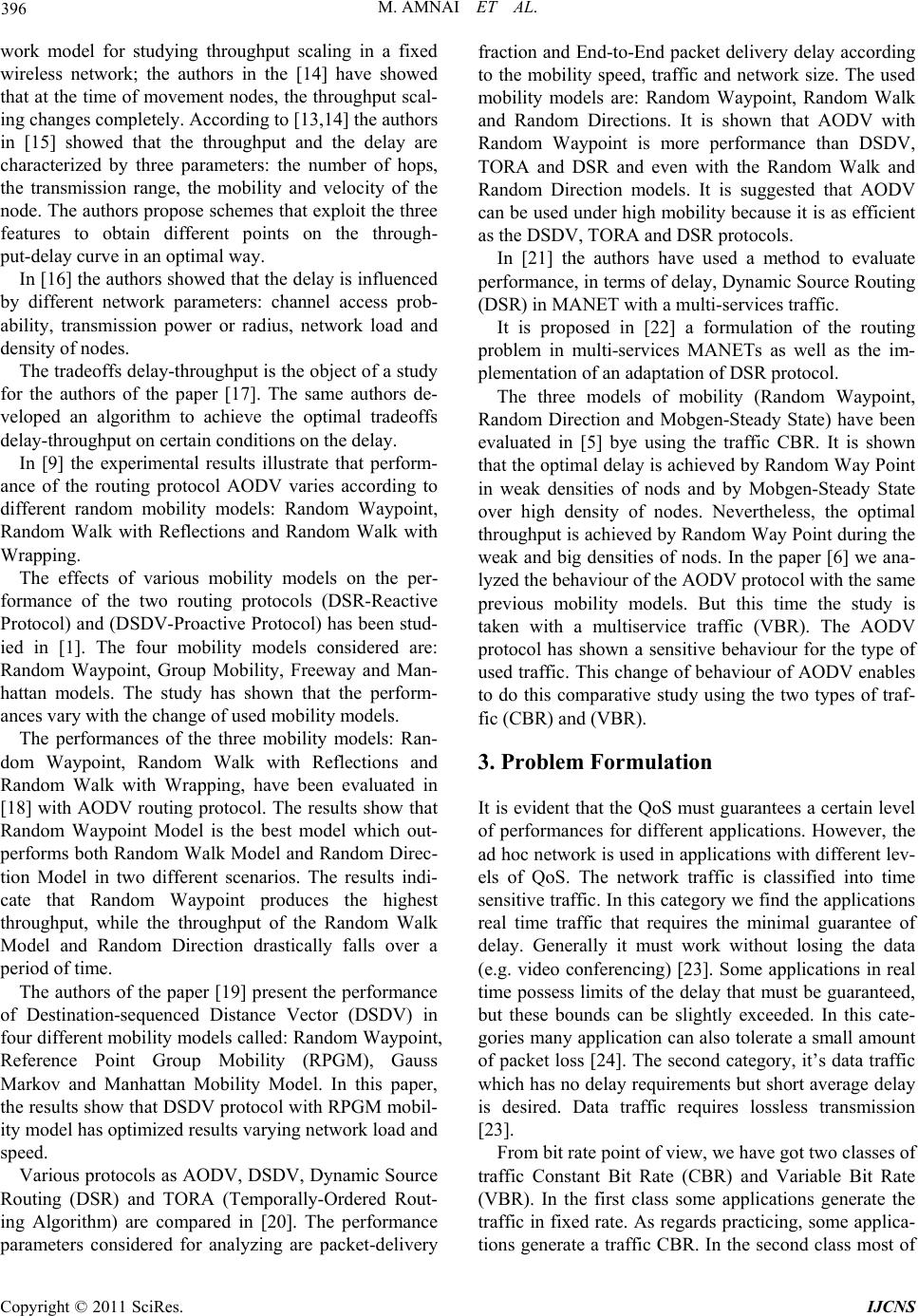 396 M. AMNAI ET AL. work model for studying throughput scaling in a fixed wireless network; the authors in the [14] have showed that at the time of movement nodes, the throughput scal- ing changes completely. According to [13,14] the author s in [15] showed that the throughput and the delay are characterized by three parameters: the number of hops, the transmission range, the mobility and velocity of the node. The authors propose schemes that exploit th e three features to obtain different points on the through- put-delay curve in an optimal way. In [16] the authors showed that th e delay is influenced by different network parameters: channel access prob- ability, transmission power or radius, network load and density of nodes. The tradeoffs delay- throughput is the obj ect of a study for the authors of the paper [17]. The same authors de- veloped an algorithm to achieve the optimal tradeoffs delay-throughput on certain conditions on the delay. In [9] the experimental results illustrate that perform- ance of the routing protocol AODV varies according to different random mobility models: Random Waypoint, Random Walk with Reflections and Random Walk with Wrapping. The effects of various mobility models on the per- formance of the two routing protocols (DSR-Reactive Protocol) and (DSDV-Proactive Protocol) has been stud- ied in [1]. The four mobility models considered are: Random Waypoint, Group Mobility, Freeway and Man- hattan models. The study has shown that the perform- ances vary with the change of used mobility models. The performances of the three mobility models: Ran- dom Waypoint, Random Walk with Reflections and Random Walk with Wrapping, have been evaluated in [18] with AODV routing protocol. The results show that Random Waypoint Model is the best model which out- performs both Random Walk Model and Random Direc- tion Model in two different scenarios. The results indi- cate that Random Waypoint produces the highest throughput, while the throughput of the Random Walk Model and Random Direction drastically falls over a period of time. The authors of the paper [19] present the performance of Destination-sequenced Distance Vector (DSDV) in four different mobility models called : Random Waypoint, Reference Point Group Mobility (RPGM), Gauss Markov and Manhattan Mobility Model. In this paper, the results show that DSDV protocol with RPGM mobil- ity model has optimized results varying network load and speed. Various protocols as AODV, DSDV, Dynamic Source Routing (DSR) and TORA (Temporally-Ordered Rout- ing Algorithm) are compared in [20]. The performance parameters considered for analyzing are packet-delivery fraction and End-to-End packet delivery delay according to the mobility speed, traffic and network size. The used mobility models are: Random Waypoint, Random Walk and Random Directions. It is shown that AODV with Random Waypoint is more performance than DSDV, TORA and DSR and even with the Random Walk and Random Direction models. It is suggested that AODV can be used under high mobility because it is as efficient as the DSDV, TORA and DSR protocols. In [21] the authors have used a method to evaluate performance, in terms of delay, Dynamic Source Routing (DSR) in MANET with a multi-services traffic. It is proposed in [22] a formulation of the routing problem in multi-services MANETs as well as the im- plementation of an adaptation of DSR protocol. The three models of mobility (Random Waypoint, Random Direction and Mobgen-Steady State) have been evaluated in [5] bye using the traffic CBR. It is shown that the optimal delay is ach ieved by Random Way Po int in weak densities of nods and by Mobgen-Steady State over high density of nodes. Nevertheless, the optimal throughput is achieved by Random Way Point during the weak and big densities of nods. In the paper [6] we ana- lyzed the behaviour of the AODV protocol with the same previous mobility models. But this time the study is taken with a multiservice traffic (VBR). The AODV protocol has shown a sensitive behaviour for the type of used traffic. This change of behaviour of AODV enables to do this comparative study using the two types of traf- fic (CBR) and (VBR). 3. Problem Formulation It is evident that the QoS must guarantees a certain level of performances for different applications. However, the ad hoc network is used in applications with different lev- els of QoS. The network traffic is classified into time sensitive traffic. In this category we find the applications real time traffic that requires the minimal guarantee of delay. Generally it must work without losing the data (e.g. video conferencing) [23]. Some applications in real time possess limits of the delay that must be guaranteed, but these bounds can be slightly exceeded. In this cate- gories many application can also tolerate a small amount of packet loss [24]. The second category, it’s data traffic which has no delay requirements but short averag e delay is desired. Data traffic requires lossless transmission [23]. From bit rate point of view, we have got two classes of traffic Constant Bit Rate (CBR) and Variable Bit Rate (VBR). In the first class some applications generate the traffic in fixed rate. As regards practicing, some applica- tions generate a traffic CBR. In the second class most of Copyright © 2011 SciRes. IJCNS 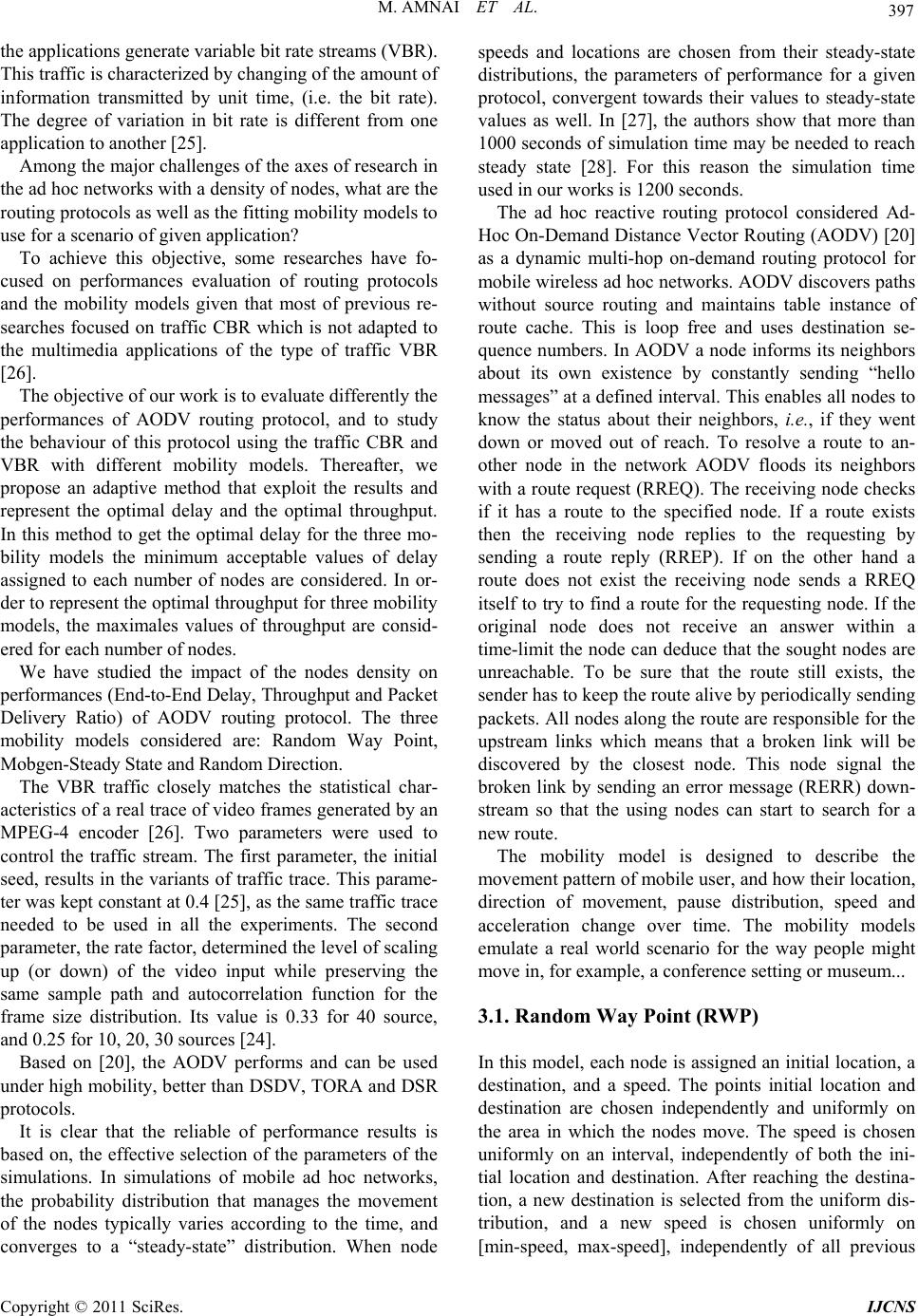 M. AMNAI ET AL. 397 the applications generate variable bit rate streams (VBR). This traffic is characterized by changing of the amount of information transmitted by unit time, (i.e. the bit rate). The degree of variation in bit rate is different from one application to another [25]. Among the major challenges of the axes of research in the ad hoc networks with a density of nodes, what are the routing protocols as well as the fitting mobility models to use for a scenario of given application? To achieve this objective, some researches have fo- cused on performances evaluation of routing protocols and the mobility models given that most of previous re- searches focused on traffic CBR which is not adapted to the multimedia applications of the type of traffic VBR [26]. The objective of ou r work is to ev alu ate differen tly th e performances of AODV routing protocol, and to study the behaviour of this protocol using the traffic CBR and VBR with different mobility models. Thereafter, we propose an adaptive method that exploit the results and represent the optimal delay and the optimal throughput. In this method to get the optimal delay for the three mo- bility models the minimum acceptable values of delay assigned to each number of nodes are considered. In or- der to represent the optimal throughpu t for three mobility models, the maximales values of throughput are consid- ered for each number of nodes. We have studied the impact of the nodes density on performances (End-to-End Delay, Throughput and Packet Delivery Ratio) of AODV routing protocol. The three mobility models considered are: Random Way Point, Mobgen-Steady St at e and R andom Direction. The VBR traffic closely matches the statistical char- acteristics of a real trace of video frames generated by an MPEG-4 encoder [26]. Two parameters were used to control the traffic stream. The first parameter, the initial seed, results in the variants of traffic trace. This parame- ter was kept constant at 0.4 [25], as the same traffic trace needed to be used in all the experiments. The second parameter, the rate factor, determined the level of scaling up (or down) of the video input while preserving the same sample path and autocorrelation function for the frame size distribution. Its value is 0.33 for 40 source, and 0.25 for 10, 20, 30 sour ces [24]. Based on [20], the AODV performs and can be used under high mobility, better than DSDV, TORA and DSR protocols. It is clear that the reliable of performance results is based on, the effective selection of the parameters of the simulations. In simulations of mobile ad hoc networks, the probability distribution that manages the movement of the nodes typically varies according to the time, and converges to a “steady-state” distribution. When node speeds and locations are chosen from their steady-state distributions, the parameters of performance for a given protocol, convergent towards their values to steady-state values as well. In [27], the authors show that more than 1000 seconds of simulation ti me may be needed to reach steady state [28]. For this reason the simulation time used in our wor ks is 1200 seconds. The ad hoc reactive routing protocol considered Ad- Hoc On-Demand Distance Vector Routing (AODV) [20] as a dynamic multi-hop on-demand routing protocol for mobile wireless ad hoc networks. AODV discovers paths without source routing and maintains table instance of route cache. This is loop free and uses destination se- quence numbers. In AODV a node informs its neighbors about its own existence by constantly sending “hello messages” at a defined interval. This enables all no des to know the status about their neighbors, i.e., if they went down or moved out of reach. To resolve a route to an- other node in the network AODV floods its neighbors with a route request (RREQ). The receiving node checks if it has a route to the specified node. If a route exists then the receiving node replies to the requesting by sending a route reply (RREP). If on the other hand a route does not exist the receiving node sends a RREQ itself to try to find a route for the requesting node. If the original node does not receive an answer within a time-limit the node can deduce that the sought nodes are unreachable. To be sure that the route still exists, the sender has to keep the route alive by periodically sen ding packets. All nodes along the route are responsible for the upstream links which means that a broken link will be discovered by the closest node. This node signal the broken link by sending an error message (RERR) down- stream so that the using nodes can start to search for a new route. The mobility model is designed to describe the movement pattern of mobile user, and how their location, direction of movement, pause distribution, speed and acceleration change over time. The mobility models emulate a real world scenario for the way people might move in, for example, a conference setting or museum... 3.1. Random Way Point (RWP) In this model, each node is assigned an initial location, a destination, and a speed. The points initial location and destination are chosen independently and uniformly on the area in which the nodes move. The speed is chosen uniformly on an interval, independently of both the ini- tial location and destination. After reaching the destina- tion, a new destination is selected from the uniform dis- tribution, and a new speed is chosen uniformly on [min-speed, max-speed], independently of all previous Copyright © 2011 SciRes. IJCNS 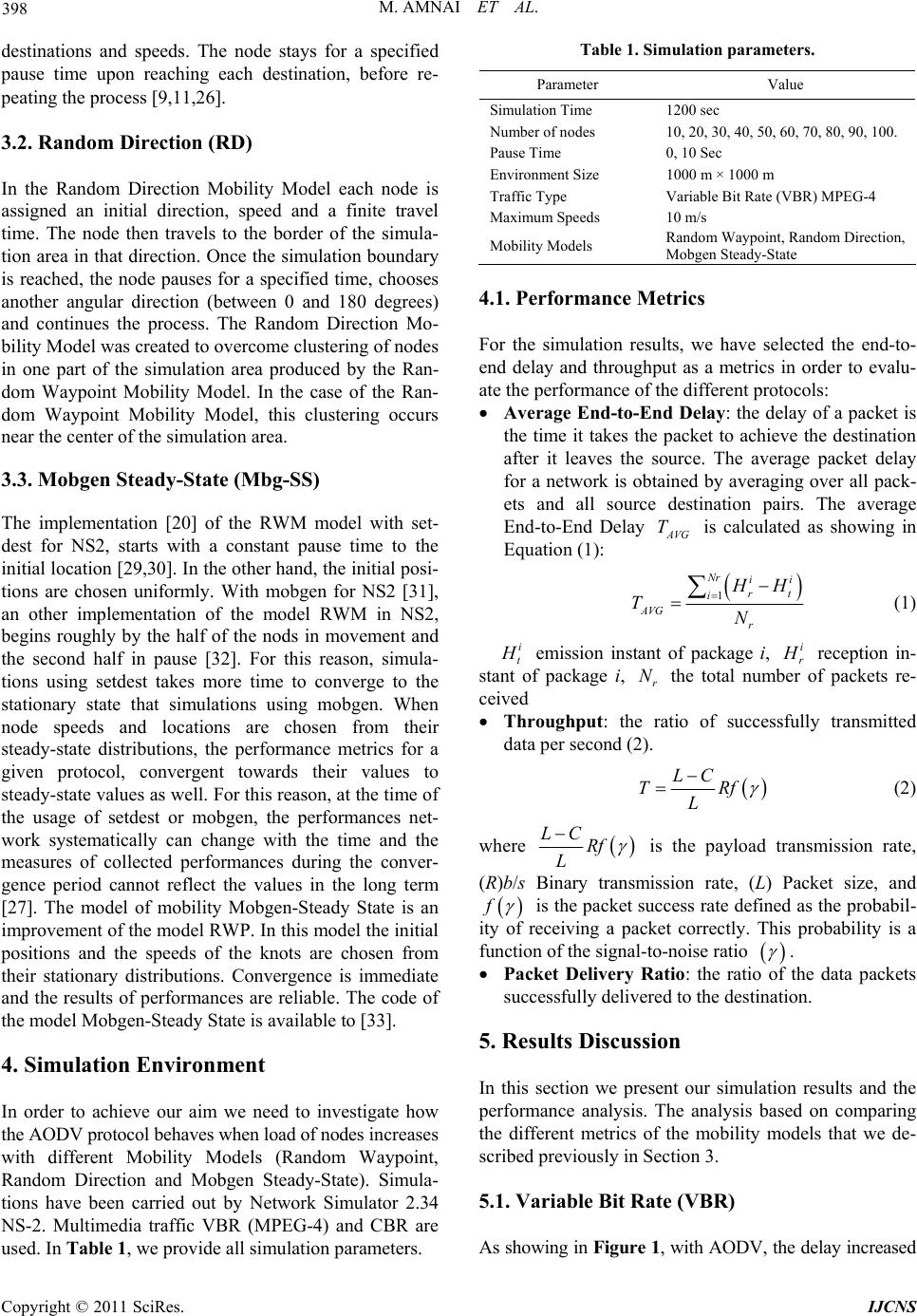 398 M. AMNAI ET AL. destinations and speeds. The node stays for a specified pause time upon reaching each destination, before re- peating the process [9,11,26]. 3.2. Random Direction (RD) In the Random Direction Mobility Model each node is assigned an initial direction, speed and a finite travel time. The node then travels to the border of the simula- tion area in that direction. Once the simulation boundary is reached, the node pauses for a specified time, chooses another angular direction (between 0 and 180 degrees) and continues the process. The Random Direction Mo- bility Model was created to overcome clustering of nod es in one part of the simulation area produced by the Ran- dom Waypoint Mobility Model. In the case of the Ran- dom Waypoint Mobility Model, this clustering occurs near the center of the simulation area. 3.3. Mobgen Steady-State (Mbg-SS) The implementation [20] of the RWM model with set- dest for NS2, starts with a constant pause time to the initial location [29,30]. In th e other hand, the initial posi- tions are chosen uniformly. With mobgen for NS2 [31], an other implementation of the model RWM in NS2, begins roughly by the half of the nods in movement and the second half in pause [32]. For this reason, simula- tions using setdest takes more time to converge to the stationary state that simulations using mobgen. When node speeds and locations are chosen from their steady-state distributions, the performance metrics for a given protocol, convergent towards their values to steady-state values as well. For this reason, at the time of the usage of setdest or mobgen, the performances net- work systematically can change with the time and the measures of collected performances during the conver- gence period cannot reflect the values in the long term [27]. The model of mobility Mobgen-Steady State is an improvement of the model RWP. In this model th e initial positions and the speeds of the knots are chosen from their stationary distributions. Convergence is immediate and the results of performances are reliable. The code of the model Mobgen-Steady State is availab le to [33]. 4. Simulation Environment In order to achieve our aim we need to investigate how the AODV protocol behaves when load of nodes increases with different Mobility Models (Random Waypoint, Random Direction and Mobgen Steady-State). Simula- tions have been carried out by Network Simulator 2.34 NS-2. Multimedia traffic VBR (MPEG-4) and CBR are used. In Table 1, we provide all simulation parameters. Table 1. Simulation parameters. Parameter Value Simulation Time 1200 sec Number of nodes 10, 20, 30, 40, 50, 60, 70, 80, 90, 100. Pause Time 0, 10 Sec Environment Size 1000 m × 1000 m Traffic Type Variable Bit Rate (VBR) MPEG-4 Maximum Spee d s 10 m/s Mobility Models Random Waypoint, Random Direction, Mobgen Steady-State 4.1. Performance Metrics For the simulation results, we have selected the end-to- end delay and throughput as a metrics in order to evalu- ate the performance of the different protocols: Average End-to-End Delay: the delay of a packet is the time it takes the packet to achieve the destination after it leaves the source. The average packet delay for a network is obtained by averaging over all pack- ets and all source destination pairs. The average End-to-End Delay AVG T is calculated as showing in Equation (1): 1 Nr ii rt i AVG r H H TN (1) i t H emission instant of package i, i r H reception in- stant of package i, the total number of packets re- ceived r N Throughput: the ratio of successfully transmitted data per second (2). LC TRf L (2) where LC Rf L is the payload transmission rate, (R)b/s Binary transmission rate, (L) Packet size, and f is the packet success rate defined as the probabil- ity of receiving a packet correctly. This probability is a function of the signal -to-noise ratio . Packet Delivery Ratio: the ratio of the data packets successfully delivered to the destination. 5. Results Discussion In this section we present our simulation results and the performance analysis. The analysis based on comparing the different metrics of the mobility models that we de- scribed previ o usl y in Section 3. 5.1. Variable Bit Rate (VBR) As showing in Figure 1, with AODV, the delay increased Copyright © 2011 SciRes. IJCNS 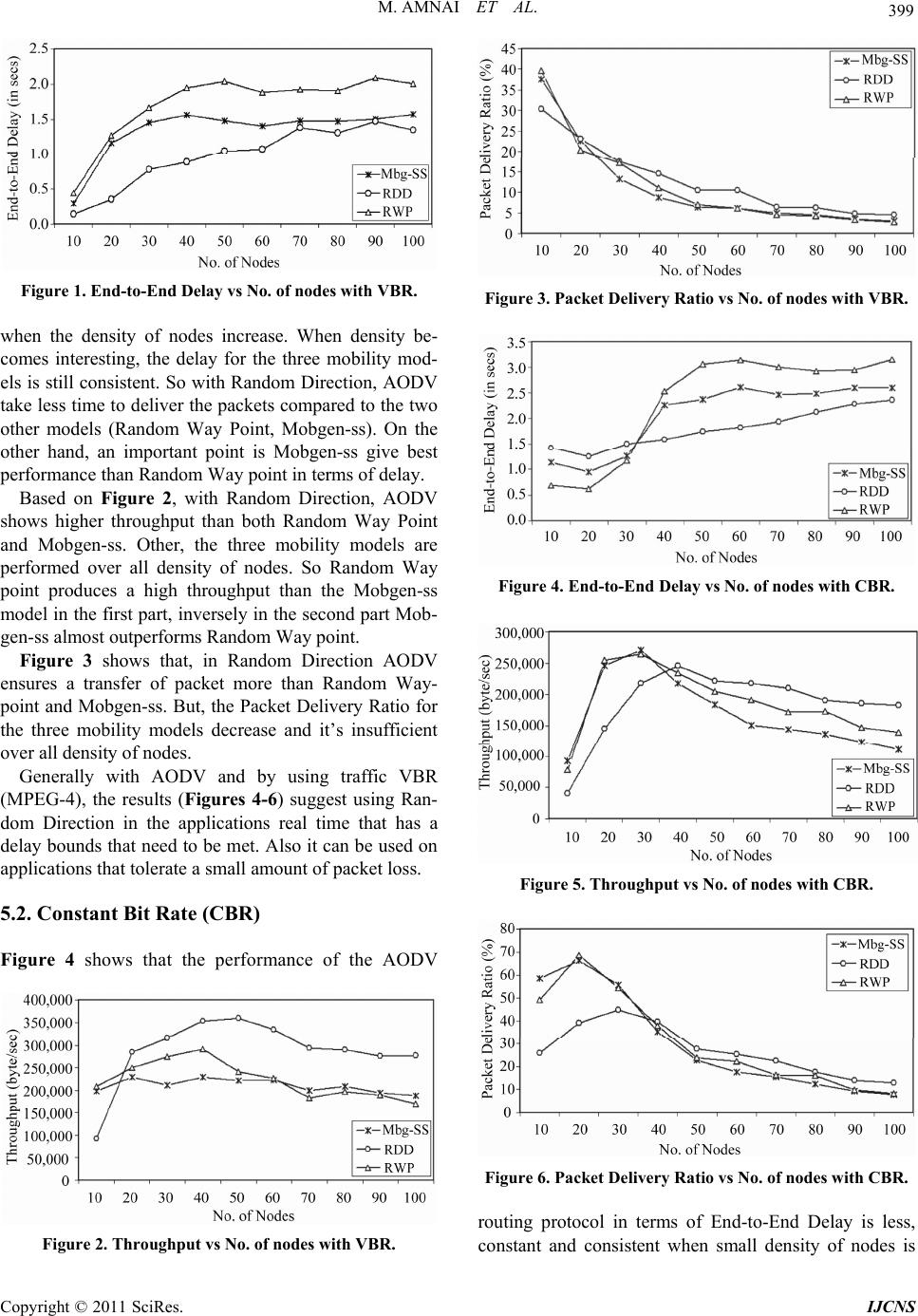 M. AMNAI ET AL. 399 Figure 1. End-to-End Delay vs No. of nodes with VBR. when the density of nodes increase. When density be- comes interesting, the delay for the three mobility mod- els is still consistent. So with Random Direction, AODV take less time to deliver the packets compared to the two other models (Random Way Point, Mobgen-ss). On the other hand, an important point is Mobgen-ss give best performance than Random Way point in terms of delay. Based on Figure 2, with Random Direction, AODV shows higher throughput than both Random Way Point and Mobgen-ss. Other, the three mobility models are performed over all density of nodes. So Random Way point produces a high throughput than the Mobgen-ss model in the first part, inversely in th e second part Mob- gen-ss almost outperforms Random Way point. Figure 3 shows that, in Random Direction AODV ensures a transfer of packet more than Random Way- point and Mobgen-ss. But, the Packet Delivery Ratio for the three mobility models decrease and it’s insufficient over all density of nodes. Generally with AODV and by using traffic VBR (MPEG-4), the results (Figures 4-6) suggest using Ran- dom Direction in the applications real time that has a delay bounds that need to be met. Also it can be used on applications that tolerate a small amount of packet loss. 5.2. Constant Bit Rate (CBR) Figure 4 shows that the performance of the AODV Figure 2. Throughput vs No. of nodes wi th VBR. Figure 3. Packet Delivery Ratio vs No. of nodes with VBR. Figure 4. End-to-End Delay vs No. of nodes with CBR. Figure 5. Throughput vs No. of nodes wi th CBR. Figure 6. Packet Delivery Ratio vs No. of nodes with CBR. routing protocol in terms of End-to-End Delay is less, constant and consistent when small density of nodes is Copyright © 2011 SciRes. IJCNS 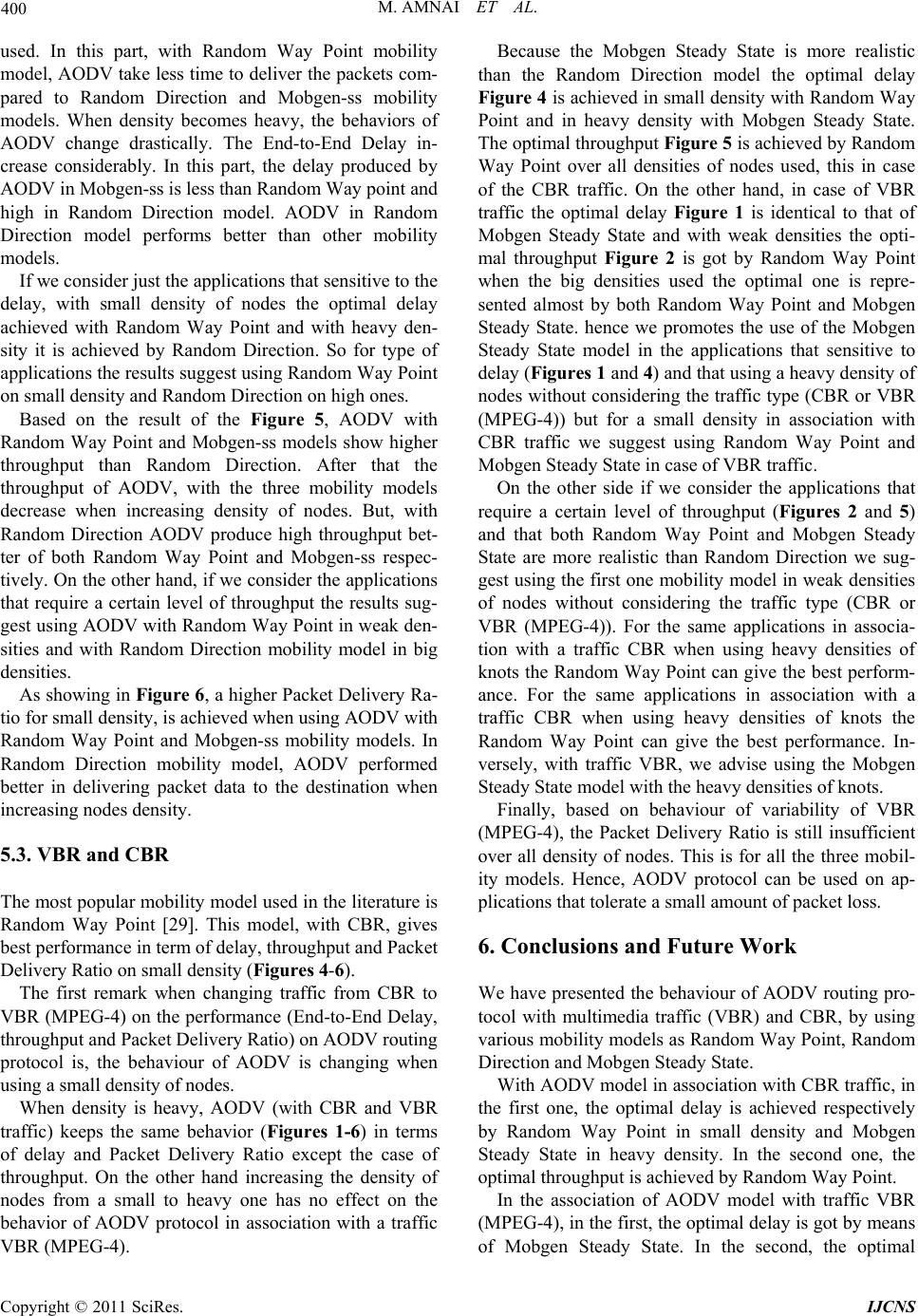 400 M. AMNAI ET AL. used. In this part, with Random Way Point mobility model, AODV take less ti me to deliver the packets com- pared to Random Direction and Mobgen-ss mobility models. When density becomes heavy, the behaviors of AODV change drastically. The End-to-End Delay in- crease considerably. In this part, the delay produced by AODV in Mobgen-ss is less than Random Way point and high in Random Direction model. AODV in Random Direction model performs better than other mobility models. If we consider just the applications th at sen sitive to th e delay, with small density of nodes the optimal delay achieved with Random Way Point and with heavy den- sity it is achieved by Random Direction. So for type of applications the results suggest using Ran dom Way Point on small density and Random Direction on high ones. Based on the result of the Figure 5, AODV with Random Way Point and Mobgen-ss models show higher throughput than Random Direction. After that the throughput of AODV, with the three mobility models decrease when increasing density of nodes. But, with Random Direction AODV produce high throughput bet- ter of both Random Way Point and Mobgen-ss respec- tively. On the other hand, if we consider the applications that require a certain level of throughput the results sug- gest using AODV with Random Way Point in weak den- sities and with Random Direction mobility model in big densities. As showing in Figure 6, a higher Packet Delivery Ra- tio for small density, is achieved when using AODV with Random Way Point and Mobgen-ss mobility models. In Random Direction mobility model, AODV performed better in delivering packet data to the destination when increasing nodes density. 5.3. VBR and CBR The most popular mobility mod el used in the literature is Random Way Point [29]. This model, with CBR, gives best performance in term of delay, throughput and Packet Delivery Ratio on small density (Figures 4-6). The first remark when changing traffic from CBR to VBR (MPEG-4) on the performance (End-to-End Delay, throughput and Pack et Delivery Ratio) on AODV routing protocol is, the behaviour of AODV is changing when using a small density of nodes. When density is heavy, AODV (with CBR and VBR traffic) keeps the same behavior (Figures 1-6) in terms of delay and Packet Delivery Ratio except the case of throughput. On the other hand increasing the density of nodes from a small to heavy one has no effect on the behavior of AODV protocol in association with a traffic VBR (MPEG-4). Because the Mobgen Steady State is more realistic than the Random Direction model the optimal delay Figure 4 is achieved in small density with Random Way Point and in heavy density with Mobgen Steady State. The optimal throug hpu t Figure 5 is achiev ed by Ra ndom Way Point over all densities of nodes used, this in case of the CBR traffic. On the other hand, in case of VBR traffic the optimal delay Figure 1 is identical to that of Mobgen Steady State and with weak densities the opti- mal throughput Figure 2 is got by Random Way Point when the big densities used the optimal one is repre- sented almost by both Random Way Point and Mobgen Steady State. hence we promotes the use of the Mobgen Steady State model in the applications that sensitive to delay (Figures 1 and 4) and that using a heavy density of nodes without considering the traffic type (CBR or VBR (MPEG-4)) but for a small density in association with CBR traffic we suggest using Random Way Point and Mobgen Steady State in case of VBR traffic. On the other side if we consider the applications that require a certain level of throughput (Figures 2 and 5) and that both Random Way Point and Mobgen Steady State are more realistic than Random Direction we sug- gest using the first one mobility model in weak densities of nodes without considering the traffic type (CBR or VBR (MPEG-4)). For the same applications in associa- tion with a traffic CBR when using heavy densities of knots the Random Way Point can give the best perform- ance. For the same applications in association with a traffic CBR when using heavy densities of knots the Random Way Point can give the best performance. In- versely, with traffic VBR, we advise using the Mobgen Steady State model with the heavy densities of knots. Finally, based on behaviour of variability of VBR (MPEG-4), the Packet Delivery Ratio is still insufficient over all density of nodes. This is for all the three mobil- ity models. Hence, AODV protocol can be used on ap- plications that tolerate a small amount of packet loss. 6. Conclusions and Future Work We have presented the behaviour of AODV routing pro- tocol with multimedia traffic (VBR) and CBR, by using various mobility models as Random Way Poin t, Random Direction and Mobgen Steady State. With AODV model in association with CBR traffic, in the first one, the optimal delay is achieved respectively by Random Way Point in small density and Mobgen Steady State in heavy density. In the second one, the optimal throughput is ach ieved by Random Way Point. In the association of AODV model with traffic VBR (MPEG-4), in the first, the optimal delay is got by means of Mobgen Steady State. In the second, the optimal Copyright © 2011 SciRes. IJCNS 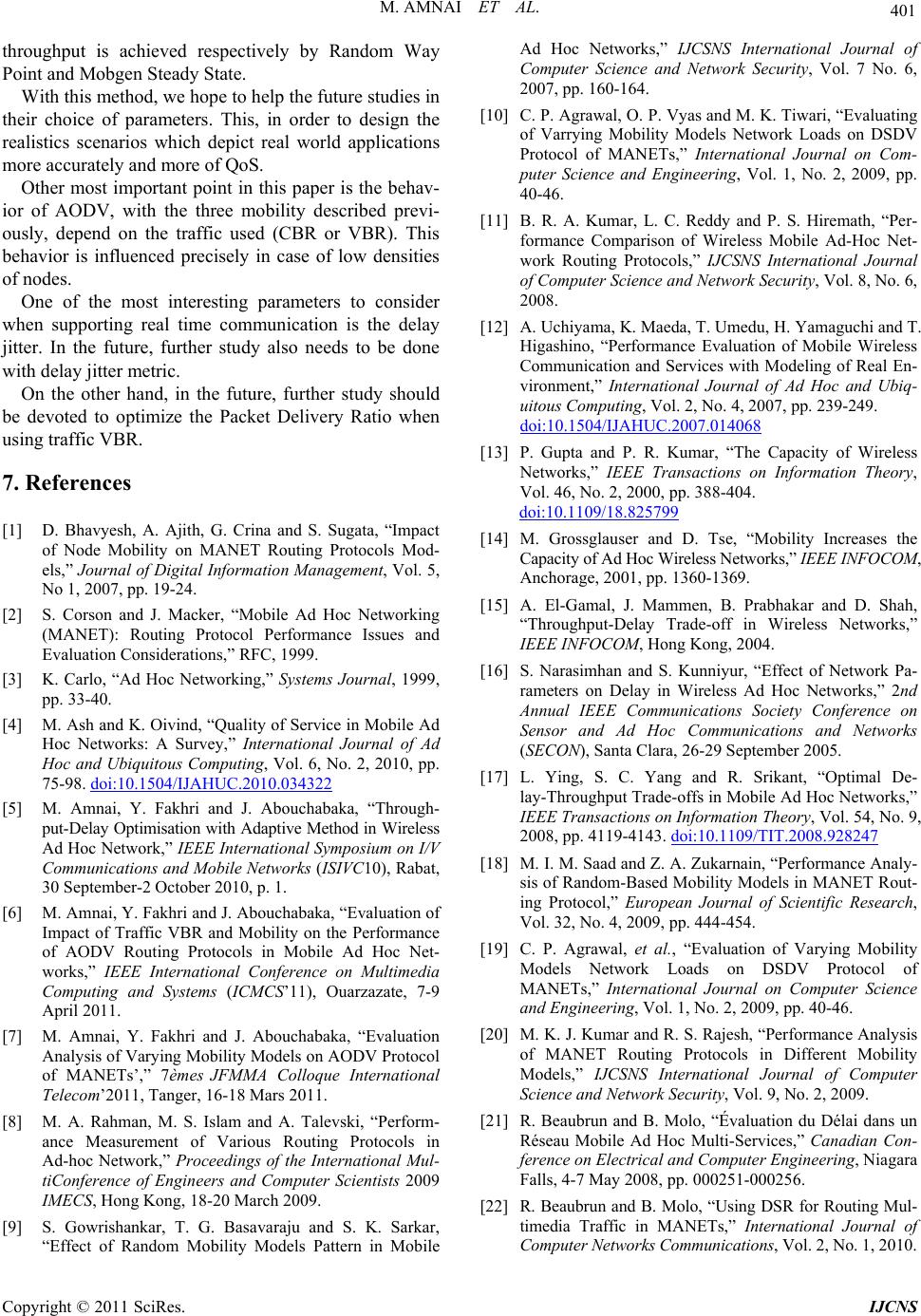 M. AMNAI ET AL. 401 throughput is achieved respectively by Random Way Point and Mobgen Steady State. With this method, we hope to help the future studies in their choice of parameters. This, in order to design the realistics scenarios which depict real world applications more accurately and more of QoS. Other most important point in this paper is the behav- ior of AODV, with the three mobility described previ- ously, depend on the traffic used (CBR or VBR). This behavior is influenced precisely in case of low densities of nodes. One of the most interesting parameters to consider when supporting real time communication is the delay jitter. In the future, further study also needs to be done with delay jitter metric. On the other hand, in the future, further study should be devoted to optimize the Packet Delivery Ratio when using traffic VBR. 7. References [1] D. Bhavyesh, A. Ajith, G. Crina and S. Sugata, “Impact of Node Mobility on MANET Routing Protocols Mod- els,” Journal of Digital Information Management, Vol. 5, No 1, 2007, pp. 19-24. [2] S. Corson and J. Macker, “Mobile Ad Hoc Networking (MANET): Routing Protocol Performance Issues and Evaluation Considerations,” RFC, 1999. [3] K. Carlo, “Ad Hoc Networking,” Systems Journal, 1999, pp. 33-40. [4] M. Ash and K. Oivind, “Quality of Service in Mobile Ad Hoc Networks: A Survey,” International Journal of Ad Hoc and Ubiquitous Computing, Vol. 6, No. 2, 2010, pp. 75-98. doi:10.1504/IJAHUC.2010.034322 [5] M. Amnai, Y. Fakhri and J. Abouchabaka, “Through- put-Delay Optimisation with Ada ptive Method in Wireless Ad Hoc Network,” IEEE International Symposium on I/V Communications and Mobile Networks (ISIVC10), Rabat, 30 September-2 October 2010, p. 1. [6] M. Amnai, Y. Fakhri and J. Abouchabaka, “Evaluation of Impact of Traffic VBR and Mobility on the Performance of AODV Routing Protocols in Mobile Ad Hoc Net- works,” IEEE International Conference on Multimedia Computing and Systems (ICMCS’11), Ouarzazate, 7-9 April 2011. [7] M. Amnai, Y. Fakhri and J. Abouchabaka, “Evaluation Analysis of Varying Mobility Models on AODV Protocol of MANETs’,” 7èmes JFMMA Colloque International Telecom’2011, Tanger, 16-18 Mars 2011. [8] M. A. Rahman, M. S. Islam and A. Talevski, “Perform- ance Measurement of Various Routing Protocols in Ad-hoc Network,” Proceedings of the International Mul- tiConference of Engineers and Computer Scientists 2009 IMECS, Hong Kong, 18-20 March 2009. [9] S. Gowrishankar, T. G. Basavaraju and S. K. Sarkar, “Effect of Random Mobility Models Pattern in Mobile Ad Hoc Networks,” IJCSNS International Journal of Computer Science and Network Security, Vol. 7 No. 6, 2007, pp. 160-164. [10] C. P. Agrawal, O. P. Vyas and M. K. Tiwari, “Evaluating of Varrying Mobility Models Network Loads on DSDV Protocol of MANETs,” International Journal on Com- puter Science and Engineering, Vol. 1, No. 2, 2009, pp. 40-46. [11] B. R. A. Kumar, L. C. Reddy and P. S. Hiremath, “Per- formance Comparison of Wireless Mobile Ad-Hoc Net- work Routing Protocols,” IJCSNS International Journal of Computer Science and Network Security, Vol. 8, No. 6, 2008. [12] A. Uchiyama, K. Maeda, T. Umedu, H. Yamaguchi and T. Higashino, “Performance Evaluation of Mobile Wireless Communication and Services with Modeling of Real En- vironment,” International Journal of Ad Hoc and Ubiq- uitous Computing, Vol. 2, No. 4, 2007, pp. 239-249. doi:10.1504/IJAHUC.2007.014068 [13] P. Gupta and P. R. Kumar, “The Capacity of Wireless Networks,” IEEE Transactions on Information Theory, Vol. 46, No. 2, 2000, pp. 388-404. doi:10.1109/18.825799 [14] M. Grossglauser and D. Tse, “Mobility Increases the Capacity of Ad Hoc Wireless Networks,” IEEE INFOCOM, Anchorage, 2001, pp. 1360-1369. [15] A. El-Gamal, J. Mammen, B. Prabhakar and D. Shah, “Throughput-Delay Trade-off in Wireless Networks,” IEEE INFOCOM, Hong Kong, 2004. [16] S. Narasimhan and S. Kunniyur, “Effect of Network Pa- rameters on Delay in Wireless Ad Hoc Networks,” 2nd Annual IEEE Communications Society Conference on Sensor and Ad Hoc Communications and Networks (SECON), Santa Clara, 26-29 September 2005. [17] L. Ying, S. C. Yang and R. Srikant, “Optimal De- lay-Throughput Trade-offs in Mobile Ad Hoc Networks,” IEEE Transactions on Information Theory, Vol. 54, No. 9, 2008, pp. 4119-4143. doi:10.1109/TIT.2008.928247 [18] M. I. M. Saad and Z. A. Zukarnain, “Performance Analy- sis of Random-Based Mobility Models in MANET Rout- ing Protocol,” European Journal of Scientific Research, Vol. 32, No. 4, 2009, pp. 444-454. [19] C. P. Agrawal, et al., “Evaluation of Varying Mobility Models Network Loads on DSDV Protocol of MANETs,” International Journal on Computer Science and Engineering, Vol. 1, No. 2, 2009, pp. 40-46. [20] M. K. J. Kumar and R. S. Rajesh, “Performance Analysis of MANET Routing Protocols in Different Mobility Models,” IJCSNS International Journal of Computer Science and Network Security, Vol. 9, No. 2, 2009. [21] R. Beaubrun and B. Molo, “Évaluation du Délai dans un Réseau Mobile Ad Hoc Multi-Services,” Canadian Con- ference on Electrical and Computer Engineering, Niagara Falls, 4-7 May 2008, pp. 000251-000256. [22] R. Beaubrun and B. Molo, “Using DSR for Routing Mul- timedia Traffic in MANETs,” International Journal of Computer Networks Communications, Vol. 2, No. 1, 2010. Copyright © 2011 SciRes. IJCNS 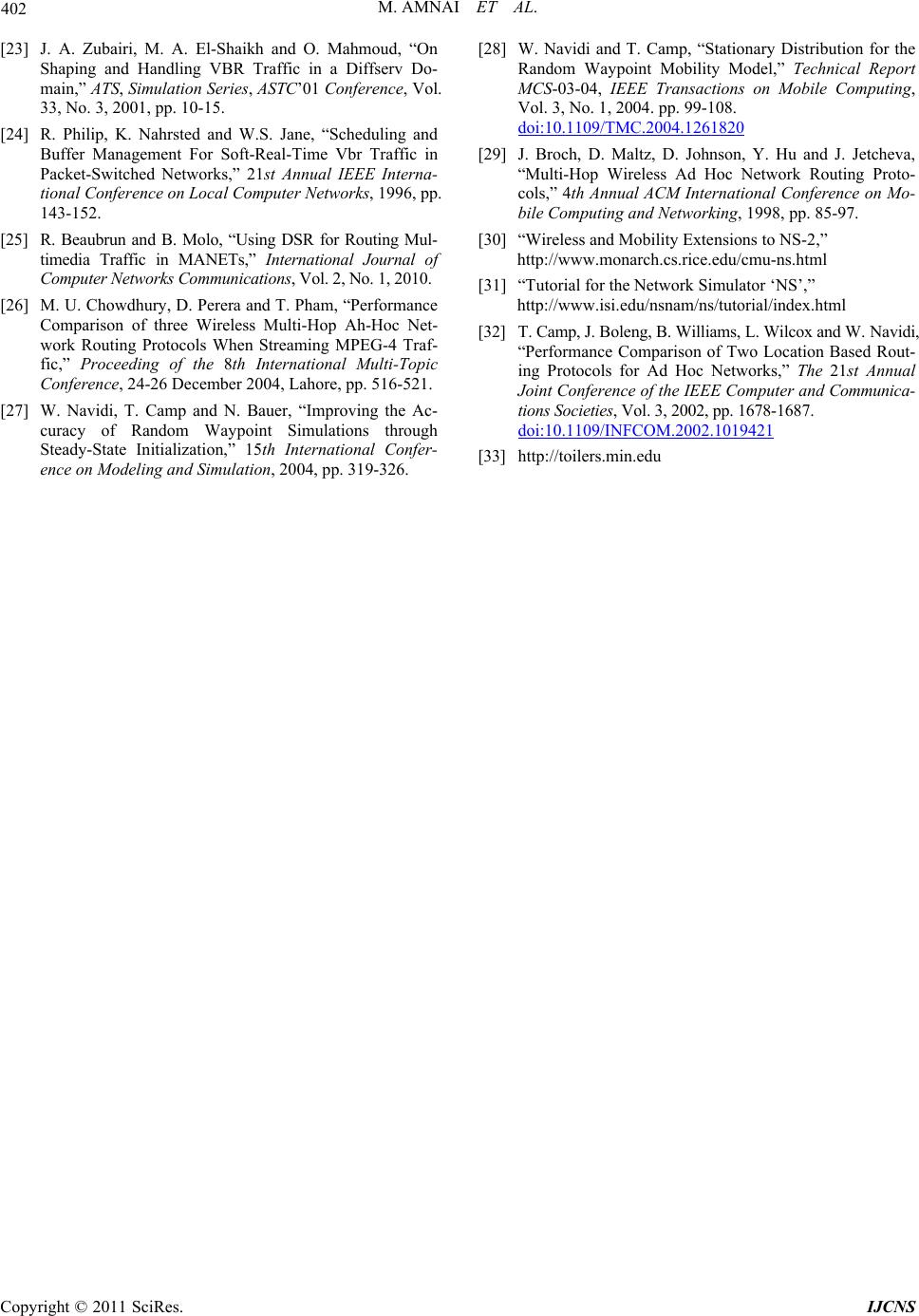 M. AMNAI ET AL. Copyright © 2011 SciRes. IJCNS 402 [23] J. A. Zubairi, M. A. El-Shaikh and O. Mahmoud, “On Shaping and Handling VBR Traffic in a Diffserv Do- main,” ATS, Simulation Series, ASTC’01 Conference, Vol. 33, No. 3, 2001, pp. 10-15. [24] R. Philip, K. Nahrsted and W.S. Jane, “Scheduling and Buffer Management For Soft-Real-Time Vbr Traffic in Packet-Switched Networks,” 21st Annual IEEE Interna- tional Conference on Local Computer Networks, 1996, pp. 143-152. [25] R. Beaubrun and B. Molo, “Using DSR for Routing Mul- timedia Traffic in MANETs,” International Journal of Computer Networks Communications, Vol. 2, No. 1, 2010. [26] M. U. Chowdhury, D. Perera and T. Pham, “Performance Comparison of three Wireless Multi-Hop Ah-Hoc Net- work Routing Protocols When Streaming MPEG-4 Traf- fic,” Proceeding of the 8th International Multi-Topic Conference, 24-26 December 2004, Lahore, pp. 516-521. [27] W. Navidi, T. Camp and N. Bauer, “Improving the Ac- curacy of Random Waypoint Simulations through Steady-State Initialization,” 15th International Confer- ence on Modeling and Simulation, 2004, pp. 319-326. [28] W. Navidi and T. Camp, “Stationary Distribution for the Random Waypoint Mobility Model,” Technical Report MCS-03-04, IEEE Transactions on Mobile Computing, Vol. 3, No. 1, 2004. pp. 99-108. doi:10.1109/TMC.2004.1261820 [29] J. Broch, D. Maltz, D. Johnson, Y. Hu and J. Jetcheva, “Multi-Hop Wireless Ad Hoc Network Routing Proto- cols,” 4th Annual ACM International Conference on Mo- bile Computing and Networking, 1998, pp. 85-97. [30] “Wireless and Mobility Extensions to NS-2,” http://www.monarch.cs.rice.edu/cmu-ns.html [31] “Tutorial for the Network Simulator ‘NS’,” http://www.isi.edu/nsnam/ns/tutorial/index.html [32] T. Camp, J. Boleng, B. Williams, L. Wilcox and W. Navidi, “Performance Comparison of Two Location Based Rout- ing Protocols for Ad Hoc Networks,” The 21st Annual Joint Conference of the IEEE Computer and Communica- tions Societies, Vol. 3, 2002, pp. 1678-1687. doi:10.1109/INFCOM.2002.1019421 [33] http://toilers.min.edu |

